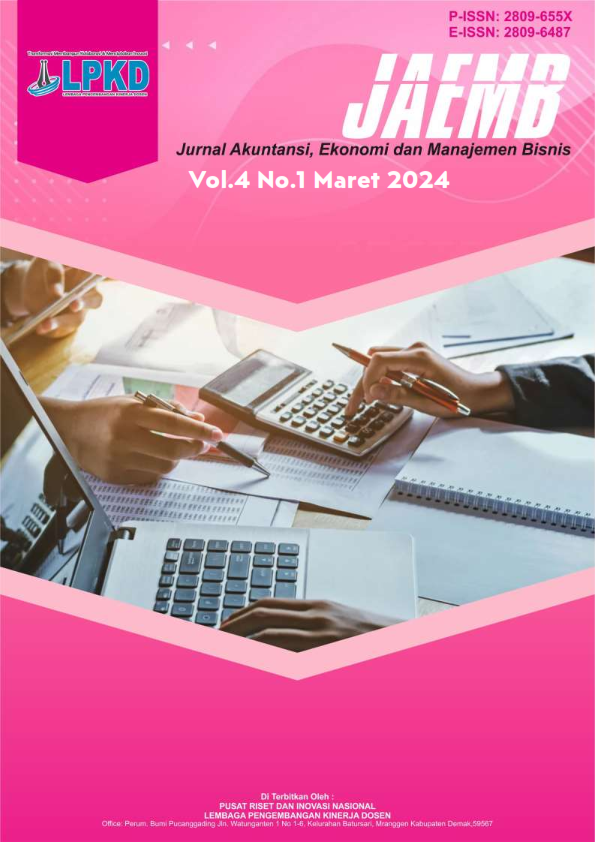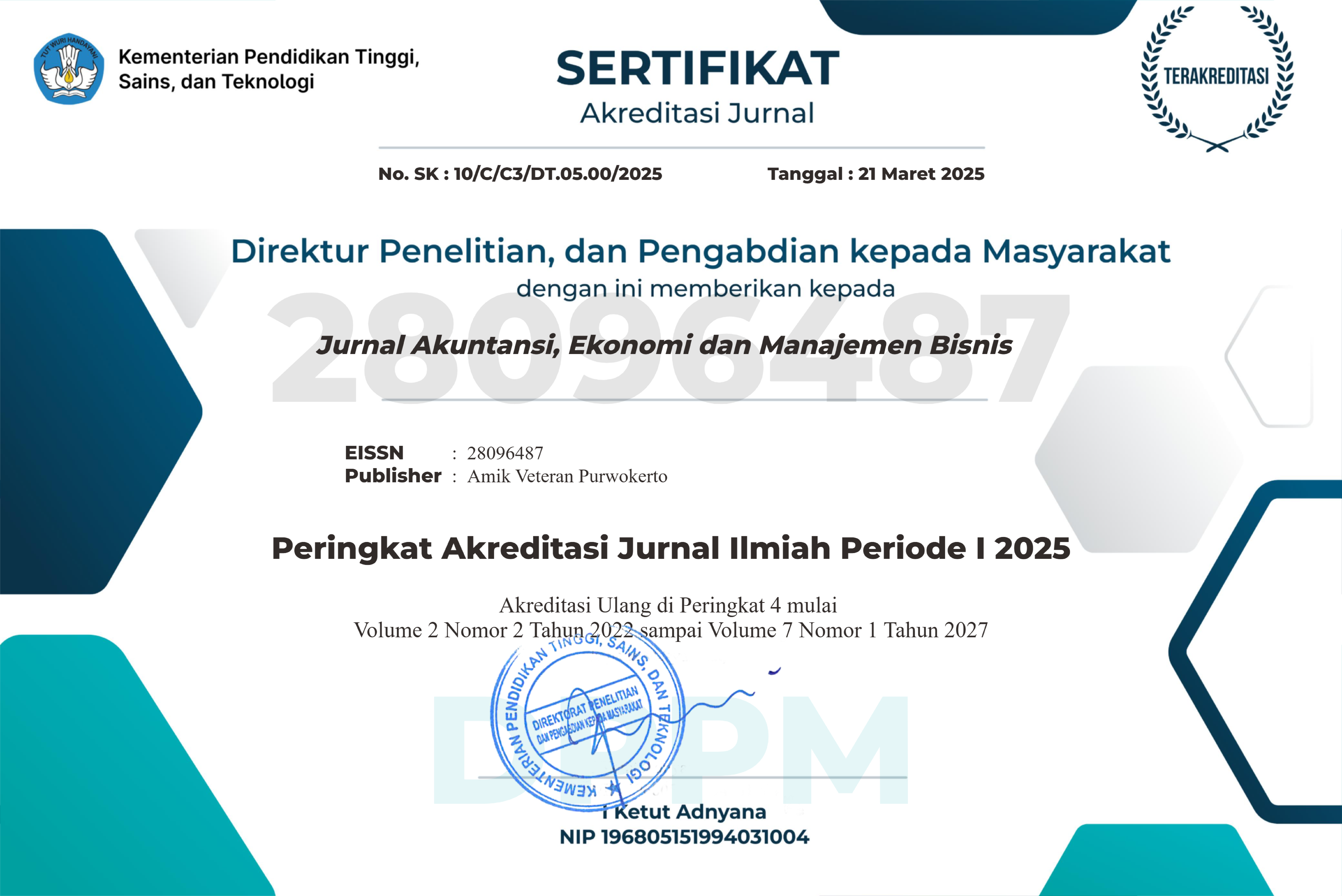Dampak Manajemen Waktu dan Pelatihan Online terhadap Kinerja Karyawan Peran Pengalaman Kerja sebagai Variabel Mediasi
DOI:
https://doi.org/10.55606/jaemb.v4i3.8514Keywords:
Time Management, Online Training, Employee Performance, Work ExperienceAbstract
This study explores the effect of Time Management (X1) and Online Training (X2) on Employee Performance (Y), with Work Experience (Z) acting as a mediating variable. This study uses Structural Equation Modeling (SEM) with Partial Least Squares (PLS) to analyze data from 96 sales employees at XL Fiberhome, Jember. The results reveal that Time Management and Online Training contribute significantly to Employee Performance, with Time Management showing a moderate direct effect and Online Training showing a slightly stronger impact. Fur-thermore, Work Experience was found to mediate the relationship between Time Management and Online Training and Employee Performance, indicating that employees with greater work experience can more effectively apply the skills acquired through time management and training. The findings of this study underscore the im-portance of integrating time management practices and continuous online training into organizational strategies to improve employee performance, especially in today's rapidly changing and flexible work environment. The sig-nificant direct and indirect effects observed in this study highlight the interrelatedness of these factors, offering new insights into how organizations can optimize performance through a combination of skill development and experience. These results contribute to the broader literature on employee performance by offering a compre-hensive model that accounts for the dynamics of evolving modern work practices. This study also provides practical recommendations for human resource management, emphasizing the need for organizations to invest in time management tools, online training platforms, and supportive work experiences to enhance productivity.
References
[1] Abdelwahed, N. A. A., &Doghan, M. A. A. (2023). Developing Employee Productivity and Performance through Work Engagement and Organizational Factors in an Educational Society. Societies, 13(3), 65. https://doi.org/10.3390/soc13030065
[2] Abro, Z., Ateeq, A. A., Milhem, M., &Alzoraiki, M. (2024). The Impact of Online Learning on Human Resource Management: A Comprehensive Review and Future Perspectives. In R. Khamis Hamdan, A. Hamdan, B. Alareeni, & R. E. Khoury (Eds.), Information and Communication Technology in Technical and Vocational Education and Training for Sustainable and Equal Opportunity: Business Governance and Digitalization of Business Education (pp. 3–11). Singapore: Springer Nature. https://doi.org/10.1007/978-981-99-7798-7_1
[3] Aitken, J. A., Kaplan, S. A., & Kuykendall, L. (2023). Going with(out) the flow at home: Day-to-day variability in flow and performance while teleworking. European Journal of Work and Organizational Psychology, 32(5), 662–677. https://doi.org/10.1080/1359432X.2023.2211271
[4] Aldhahi, M. I., Alqahtani, A. S., Baattaiah, B. A., & Al-Mohammed, H. I. (2022). Exploring the relationship between students’ learning satisfaction and self-efficacy during the emergency transition to remote learning amid the coronavirus pandemic: A cross-sectional study. Education and Information Technologies, 27(1), 1323–1340. https://doi.org/10.1007/s10639-021-10644-7
[5] Alshammari, M. H., &Alenezi, A. (2023). Nursing workforce competencies and job satisfaction: The role of technology integration, self-efficacy, social support, and prior experience. BMC Nursing, 22(1), 308. https://doi.org/10.1186/s12912-023-01474-8
[6] Awada, M., Lucas, G., Becerik-Gerber, B., & Roll, S. (2021). Working from home during the COVID-19 pandemic: Impact on office worker productivity and work experience. WORK, 69(4), 1171–1189. https://doi.org/10.3233/WOR-210301
[7] Azizi, M. R., Atlasi, R., Ziapour, A., Abbas, J., & Naemi, R. (2021). Innovative human resource management strategies during the COVID-19 pandemic: A systematic narrative review approach. Heliyon, 7(6). https://doi.org/10.1016/j.heliyon.2021.e07233
[8] Baloch, Q. B., Maher, S., Iqbal, N., Shah, S. N., Sheeraz, M., Raheem, F., & Khan, K. I. (2021). Role of organizational environment in sustained organizational economic performance. Business Process Management Journal, 28(1), 131–149. https://doi.org/10.1108/BPMJ-02-2021-0084
[9] Boccoli, G., Gastaldi, L., & Corso, M. (2023). The evolution of employee engagement: Towards a social and contextual construct for balancing individual performance and wellbeing dynamically. International Journal of Management Reviews, 25(1), 75–98. https://doi.org/10.1111/ijmr.12304
[10] Bommaraju, R., Arunachalam, S., & Hohenberg, S. (2025). Multi-Segment and Single-Segment Sales Contests: Evidence of Their Effectiveness and the Underlying Mechanisms. Journal of Marketing Research, 62(3), 447–465. https://doi.org/10.1177/00222437241307577
[11] Cheng, X. (2023). Looking through goal theories in language learning: A review on goal setting and achievement goal theory. Frontiers in Psychology, 13. https://doi.org/10.3389/fpsyg.2022.1035223
[12] Galjanić, K., Marović, I., & Hanak, T. (2023). Performance Measurement Framework for Prediction and Management of Construction Investments. Sustainability, 15(18), 13617. https://doi.org/10.3390/su151813617
[13] Giannakos, M. N., Mikalef, P., & Pappas, I. O. (2022). Systematic Literature Review of E-Learning Capabilities to Enhance Organizational Learning. Information Systems Frontiers, 24(2), 619–635. https://doi.org/10.1007/s10796-020-10097-2
[14] Hemsworth, D., Muterera, J., Khorakian, A., & Garcia-Rivera, B. R. (2024). Exploring the Theory of Employee Planned Behavior: Job Satisfaction as a Key to Organizational Performance. Psychological Reports, 00332941241252784. https://doi.org/10.1177/00332941241252784
[15] Hiremath, N. V., Mohapatra, A. K., &Paila, A. S. (2021). A study on digital learning, learning and development interventions and learnability of working executives in corporates. American Journal of Business, 36(1), 35–61. https://doi.org/10.1108/AJB-09-2020-0141
[16] Ivasciuc, I. S., Epuran, G., Vuță, D. R., &Tescașiu, B. (2022). Telework Implications on Work-Life Balance, Productivity, and Health of Different Generations of Romanian Employees. Sustainability, 14(23), 16108. https://doi.org/10.3390/su142316108
[17] Jasinenko, A., & Steuber, J. (2023). Perceived Organizational Purpose: Systematic Literature Review, Construct Definition, Measurement and Potential Employee Outcomes. Journal of Management Studies, 60(6), 1415–1447. https://doi.org/10.1111/joms.12852
[18] Jimad, H., Roslina, R., &Yuningsih, Y. (2024). The effect of flexible working arrangements on educator performance in Indonesia. International Journal of Educational Management, 38(7), 1944–1958. https://doi.org/10.1108/IJEM-12-2023-0631
[19] Kumar, P., Kumar, N., Aggarwal, P., & Yeap, J. A. L. (2021). Working in lockdown: The relationship between COVID-19 induced work stressors, job performance, distress, and life satisfaction. Current Psychology, 40(12), 6308–6323. https://doi.org/10.1007/s12144-021-01567-0
[20] Pedota, M., & Piscitello, L. (2022). A new perspective on technology-driven creativity enhancement in the Fourth Industrial Revolution. Creativity and Innovation Management, 31(1), 109–122. https://doi.org/10.1111/caim.12468
[21] Pichler, S., Kohli, C., & Granitz, N. (2021). DITTO for Gen Z: A framework for leveraging the uniqueness of the new generation. Business Horizons, 64(5), 599–610. https://doi.org/10.1016/j.bushor.2021.02.021
[22] Rasool, T., Warraich, N. F., & Sajid, M. (2022). Examining the Impact of Technology Overload at the Workplace: A Systematic Review. SAGE Open, 12(3), 21582440221114320. https://doi.org/10.1177/21582440221114320
[23] Ryan, R., Deci, E., Vansteenkiste, M., &Soenens, B. (2021). Building a science of motivated persons: Self-determination theory’s empirical approach to human experience and the regulation of behavior. Motivation Science. https://doi.org/10.1037/mot0000194
[24] Saraiva, M., &Nogueiro, T. (2025). Perspectives and Realities of Disengagement Among Younger Generation Y and Z Workers in Contemporary Work Dynamics. Administrative Sciences, 15(4), 133. https://doi.org/10.3390/admsci15040133
[25] Shahriar, S. H. B., Arafat, S., Islam, I., Nur, J. M. E. H., Rahman, S., Khan, S. I., & Alam, M. S. (2022). The emergence of e-learning and online-based training during the COVID-19 crisis: An exploratory investigation from Bangladesh. Management Matters, 20(1), 1–15. https://doi.org/10.1108/MANM-01-2022-0007
[26] Shan, Z., & Wang, Y. (2024). Strategic Talent Development in the Knowledge Economy: A Comparative Analysis of Global Practices. Journal of the Knowledge Economy, 15(4), 19570–19596. https://doi.org/10.1007/s13132-024-01933-w
[27] Singh, S. (2025). Effective Time Management Key to WorkLife Balance. Notion Press.
[28] Swann, C., Rosenbaum, S., Lawrence, A., Vella, S. A., McEwan, D., &Ekkekakis, P. (2021). Updating goal-setting theory in physical activity promotion: A critical conceptual review. Health Psychology Review, 15(1), 34–50. https://doi.org/10.1080/17437199.2019.1706616
[29] Wang, L., & Xie, T. (2023). Double-Edged Sword Effect of Flexible Work Arrangements on Employee Innovation Performance: From the Demands–Resources–Individual Effects Perspective. Sustainability, 15(13), 10159. https://doi.org/10.3390/su151310159
[30] Weintraub, J., Cassell, D., & DePatie, T. P. (2021). Nudging flow through ‘SMART’ goal setting to decrease stress, increase engagement, and increase performance at work. Journal of Occupational and Organizational Psychology, 94(2), 230–258. https://doi.org/10.1111/joop.12347
[31] Wolters, C. A., & Brady, A. C. (2021). College Students’ Time Management: A Self-Regulated Learning Perspective. Educational Psychology Review, 33(4), 1319–1351. https://doi.org/10.1007/s10648-020-09519-z
[32] Wu, T. (2021). Digital project management: Rapid changes define new working environments. Journal of Business Strategy, 43(5), 323–331. https://doi.org/10.1108/JBS-03-2021-0047
[33] Yener, S., Arslan, A., & Kilinç, S. (2020). The moderating roles of technological self-efficacy and time management in the technostress and employee performance relationship through burnout. Information Technology & People, 34(7), 1890–1919. https://doi.org/10.1108/ITP-09-2019-0462
Downloads
Published
How to Cite
Issue
Section
License
Copyright (c) 2024 Jurnal Akuntansi, Ekonomi dan Manajemen Bisnis

This work is licensed under a Creative Commons Attribution-ShareAlike 4.0 International License.








